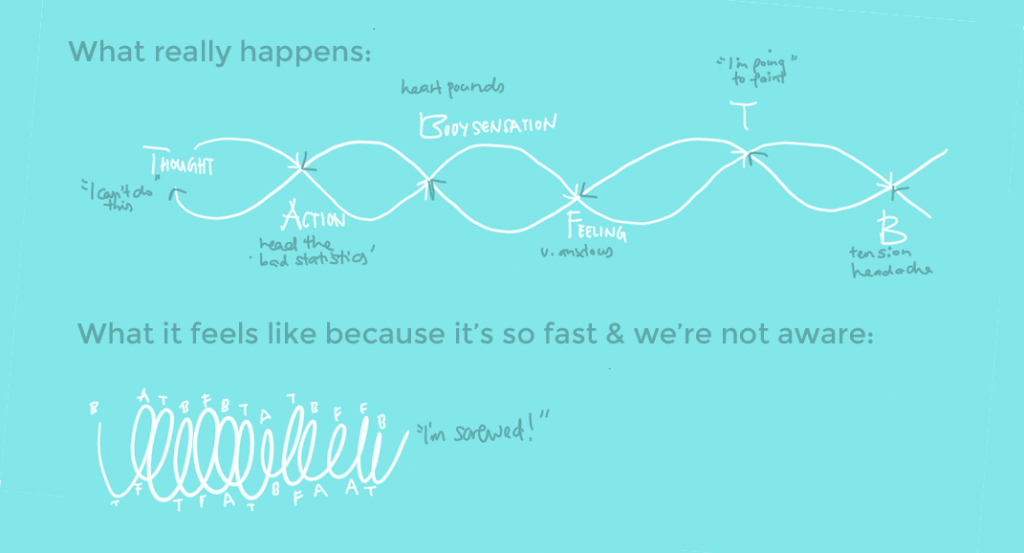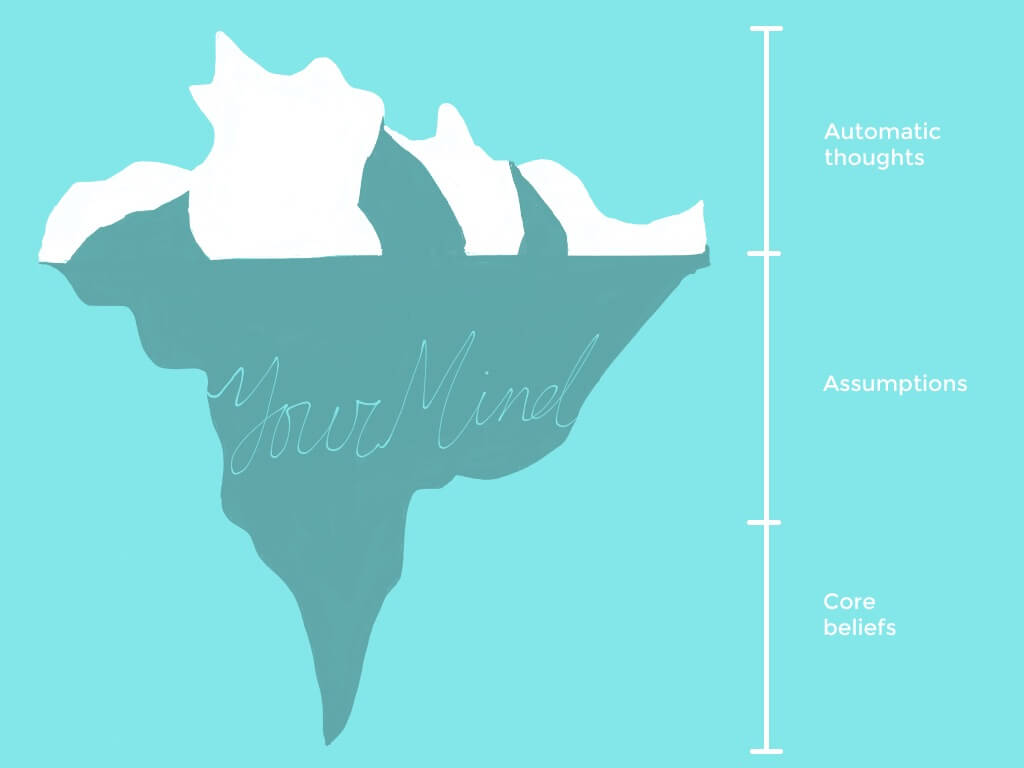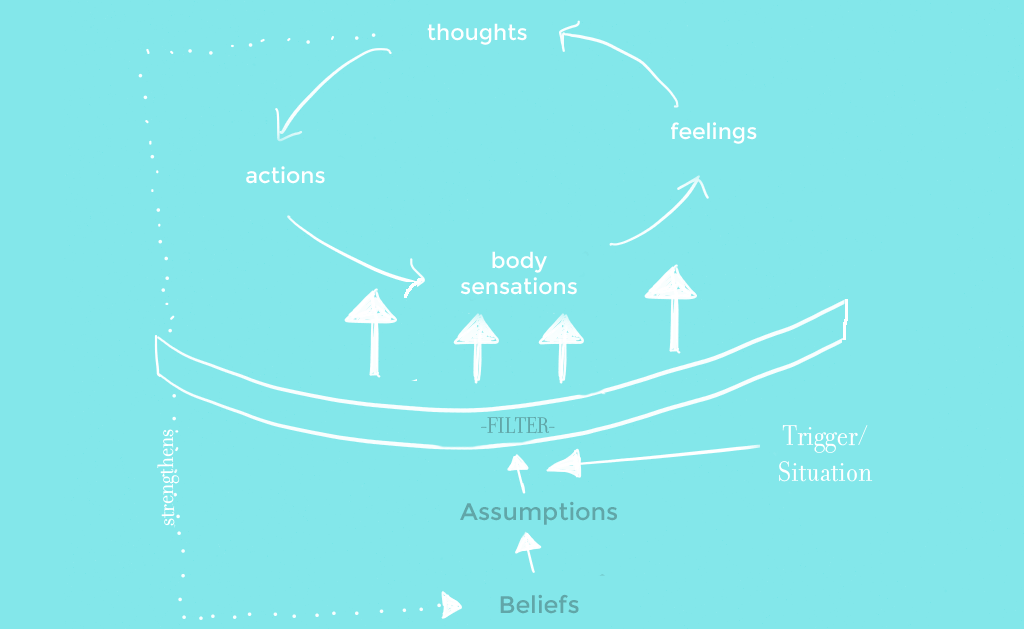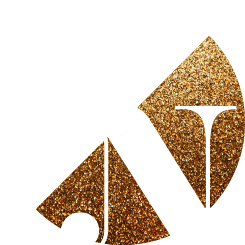I’ve always been fascinated by why some people dress to fly, looking forward to the movies and food. And why others have shaky legs and cold hands as they board, clutching their arsenal of relaxant pills. Similarly, our thoughts, body sensations, feelings and actions are linked in our day-to-day-life. They’re so automatic, we don’t know they’re separate steps of a cycle. And so we feel helpless. When we put these under a microscope to disentangle them, we slow down the automatic cycle by working on one of the thought/feeling/body/action components. This way, we regain some control. Cognitive-behavioral therapy (CBT) is that microscope.

One idea I always hear about CBT is “It’s about just changing your thinking, right?”. Wrong. Thought surgery does sound useful. But the thoughts you’re aware of barely scratch the surface of your mind. If you feel anxious about flying, you may think “I can’t do this” and “This is scary”. But that’s not all. A good CBT therapist will help you understand the deeper layers that drive your automatic thoughts.

If our thoughts are the visible part of the iceberg of the mind, then our assumptions are below the surface. They are ideas like “If I fly, something bad will happen”, and “If I hyperventilate on the plane, I’ll look really stupid”. We’re so convinced because we’ve fed them for so long. They’ve been planted by experiences- things that happened to us and people we know, books we’ve read, stories we’ve heard. Over time, these assumptions solidify into beliefs we’re not even aware about. Such as “I have bad luck”, “The plane will crash”, “Planes are dangerous”. We carry these stories with us. And forget about the other side of the story- not all planes crash, and our fortunes vary. Our filters are biased.

The Thought/Feeling/Body/Action Cycle
Our beliefs are the foundation of our assumptions, which feed our thoughts. These thoughts are linked to your body sensations, feelings and actions. My friend Tina was very scared of flying. The thought of getting on a plane made her heart race. Untill recently, she only took cruise ships and coaches, to ‘prevent bad luck from happening’. So she never proved her assumptions and beliefs wrong. Whenever her husband invited her ontrips, Tina Googled for hours on plane crashes and engine failure. These stories stayed in her mind. And so the vicious cycle between her body, feelings, actions and thoughts persisted.
Recently, Tina’s son enrolled in Harvard. 20 hours away by plane. Tina knew she’d to overcome her fear. So she learned more about her thoughts. She learned that ‘looking stupid’ masked the real problem- she didn’t know how to manage her anxiety. Tina thought hard to unearth her beliefs. When she was 7, her father was abroad, and she watched a news report on a plane crash. Tina was aghast. Nobody else knew, but she thought her father was dead. Even though he returned, she thought, “planes are how families break up”. Decades later, her body remembered the pain in her heart, the soreness in her upper back, and the pit in her stomach. That realisation was illuminating. It freed her.
Minor diversion. I also asked some why they love to fly. Their answers? From a young age, they’d been told how wonderful flying is. That just flying on an aeroplane itself is a marvellous, exciting experience.
Back to Tina. In CBT, she enjoyed challenging her beliefs like the defence and prosecution teams in a court of law. Tina also learned mindfulness and self-compassion techniques- which are considered ‘3rd wave CBT approaches’. She asked her aircraft engineer friend if she could practise going in and out of aeroplanes. By doing these experiments, she gave herself the opportunity to prove her old beliefs wrong. When she took her first long-haul flight, she learned she can handle.
CBT creates positive cycles
Tina also learned something else with CBT. She learned about her positive thoughts/feelings/body/action cycles, which she called Wonder Cycles. She learned how mindfulness soothed her racing mind, and reduced her tension headaches. With less stress and better sleep, Tina found that she could manage her team better and enjoy her life more.
To me, Tina’s story is testament to how “CBT is used to deal with negative thinking” couldn’t be more untrue. If any therapist or site tells you that, be very suspicious. It’s about self-awareness, healing your mind and body, and creating positive habits. Just like how Tina became her own heroine, giving herself the tools to heal and overcome.
Got a question about CBT? Leave a comment or Pop me a mail. I read every email.





